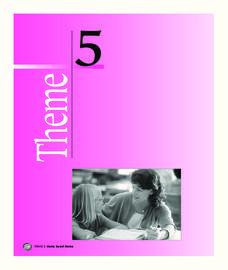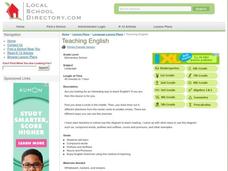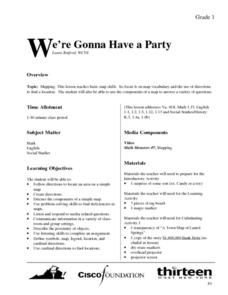Curated OER
Ordinary People: Cubing Strategy
Readers of Ordinary People employ a cubing strategy based on Bloom’s Taxonomy to analyze, from multiple perspectives, an excerpt from Chapter 10 of Judith Guest’s novel. The excerpt, a rationale and complete directions for the...
Scholastic
Frindle Lesson Plan
"Who says a pen has to be called a pen? Why not call it a frindle?" Inspired by this quote from the award-winning novel written by Andrew Celements, this lesson allows children to invent their own...
Houghton Mifflin Harcourt
Home Sweet Home: Extra Support Lessons (Theme 5)
Home Sweet Home is the theme of a unit comprised of extra support lessons. Scholars reinforce concepts through chants, grand discussions, and practice worksheets. Topics include digraphs, blending phoneme, long vowels, final sounds,...
Novelinks
Zach’s Lie: Guided Imagery
Close your eyes and picture a time where you decided to tell the truth to someone. What were you wearing? How did you feel? Such prompts begin a guided imagery activity for Zach's Lie. Directions for creating an environment conducive to...
Houghton Mifflin Harcourt
A World of Animals: Extra Support Lessons (Theme 10)
Provide extra support with this collection of animal-themed lessons. Early readers gain proficiency in high frequency words are and he, practice blending short vowel sounds, and substitute initial and final phonemes while...
K12 Reader
Step by Step Instructions
Here's a worksheet that not only provides readers with information about crafting step-by-step directions for a science project, but also serves as a reading comprehension exercise.
Curated OER
Giving and Taking Directions
Students identify the difference between commands and a declarative sentence. They complete a diagram with verbs, prepositions and numbers. They follow directions using a map and give directions to another location.
Curated OER
Giving and Taking Directions (Middle School)
Middle schoolers describe the difference between a declarative sentence and a command. They complete a diagram verbs, prepositions and numbers. They follow directions on a map and create directions of their own to another location.
Curated OER
Teachers.Net Lesson Exchange: Classroom Objects (other, other
Learners study the names of classroom objects, then examine their cards and read the information silently and very carefully.
Curated OER
Teaching English
Students use a word web to study about the different grammar components. They use the diagram with nouns, pronouns, suffixes, prefixes, compound words, and other examples for an interesting way to study about English.
Curated OER
English as an Additional Language: Topic Book 10: Common Objects
In this ESL common objects instructional activity, students respond to 6 matching questions, 46 short answer questions, and 8 drawing questions pertaining to colors, directions, and counting, and identifying common objects.
Curated OER
Unit 2: Subject/Object Pronouns School
In this grammar worksheet, learners underline the pronouns in a conversation about school. They locate all of the subject/object pronouns.
Curated OER
Language Arts: Inside, Outside, Upside Down
Students create a computer slide show of pictures representing directional words. After listening to several books with examples, they pair words such as inside and outside, below and above, or high and low. With older students or...
Curated OER
We're Gonna Have A Party
First graders explore map skills. They discuss the map vocabulary and use directions to find a location on a map. Students discuss and use the components of a map to answer a variety of questions. They use the map and directions to find...
Virginia Department of Education
Identifying the Main Idea in Fiction
Discovering the main idea in fiction is like uncovering buried treasure; one must persevere to locate it, and the reward is priceless. Scholars delve deep into leveled stories using three questions to aid in identifying the main idea.
San José State University
Transitive and Intransitive Verbs
Clarify the difference between transitive and intransitive verbs and when to use lay versus lie. Various examples are given before writers practice underlining verbs, circling the object of each verb, and filling in sentences with either...
Curated OER
Who / Whom Practice
In this nominative and objective pronouns worksheet, young scholars read the rules for using "who" and "whom". Students read ten sentences and indicate which word is correct for each.
Curated OER
What's the Case? - The Three Cases of a Personal Pronoun
In this grammar worksheet, students learn about personal pronouns (subject, object and possessive) in sentence writing. They then answer the 14 questions on the worksheet. The answers are on the last page of the packet.
Curated OER
Troublesome Word Pairs
This worksheet helps to understand when to use commonly confused words. It includes definitions, writing exercises, and questions that require paraphrasing the meaning of sentences. A good exercise for middle schoolers, or review for...
Curated OER
Subject and Object Pronouns
In this pronoun instructional activity, students review the definitions of subject and object pronouns. Students then complete three pages of exercises about pronouns.
Curated OER
Gerunds and Gerund Phrases
In this gerunds and gerund phrases worksheet, students practice their grammar skills as they identify the gerunds or gerund phrases in 10 sentences. Students read 8 more sentences and identify each gerund or gerund phrase as a subject,...
Curated OER
Unit 2: Subject/Object Pronouns Health
In this grammar worksheet, student choose the correct pronouns to replace the underlined words in a dialogue about having a prescription filled. They insert the proper pronoun in 5 places in the entry.
Curated OER
Coral And Kelp Game Direction- Beginning C Or K
In this initial c or k spelling game, students color and cut out 12 game cards. Each has a picture, with a c or k word with the first letter missing. Detailed instructions and a game board are included.
Curated OER
Colors
A tricky activity on color words is sure to challenge your kindergarten readers. They match color words to pictures that correspond to each color - yellow for banana, for example. Next, kids color a paint set to match four color words....























